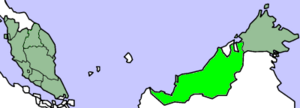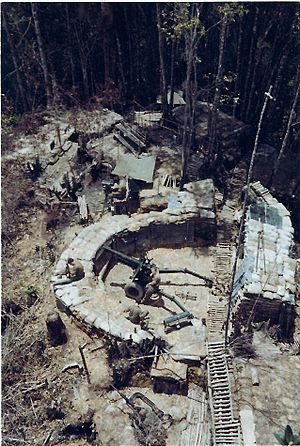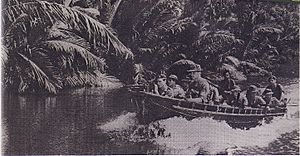Operation Claret facts for kids
Quick facts for kids Operation Claret |
|
|---|---|
 Sarawak |
|
| Planned by | |
| Objective | Keep Indonesian forces off balance |
| Date | July 1964 – July 1966 |
| Outcome | British Commonwealth success |
Operation Claret was a secret mission carried out by British Commonwealth forces between July 1964 and July 1966. These operations took place during the Indonesia–Malaysia confrontation, a time when Indonesia and the newly formed Malaysia had disagreements. The missions were launched from East Malaysia (Sarawak and Sabah) into Indonesian Kalimantan.
The main goal of Operation Claret was to stop Indonesian forces from attacking Malaysia. Instead of waiting to be attacked, the British and Malaysian governments wanted to make the Indonesian forces stay on the defensive. This way, Indonesian troops couldn't easily plan attacks from their safe bases in Kalimantan. The operations were kept very secret to avoid making Indonesia angry or giving them a reason to say they were being attacked unfairly. Even though some journalists knew, any British casualties were reported as happening inside East Malaysia.
These missions involved both special forces and regular soldiers. Special forces, like reconnaissance patrols, would cross the border to find and watch Indonesian troops. Regular soldiers would then use this information to ambush or attack the Indonesians. These actions were called "deniable" because they crossed into another country. However, they were seen as necessary to chase and stop enemy forces. Operation Claret helped the British Commonwealth forces gain an advantage and kept the Indonesians busy defending themselves.
Contents
Why Operation Claret Started
The border between East Malaysia and Kalimantan wasn't always clear. From late 1963, special forces patrols often crossed this unclear border. By early 1964, Indonesian attacks across the border became more frequent. These attacks were no longer just by untrained volunteers but by Indonesian armed forces. This worried the Director of Borneo Operations (DOBOPS), Major General Walter Walker.
In July 1964, the British government allowed offensive operations up to about 5,000 yards (4,572 meters) into Indonesian territory. These missions were given the code name Claret. DOBOPS added strict rules for these operations, known as the "Golden Rules":
- Every operation needed approval from DOBOPS.
- Only highly trained soldiers could take part.
- Operations could only go a certain distance into Indonesia. Attacks were only to stop enemy actions, not for revenge.
- No harm to civilians was allowed.
- No air support could be used, except in extreme emergencies.
- Each operation had to be planned and practiced for at least two weeks.
- All operations had to be kept top secret. Soldiers were sworn to secrecy, and no details could be discussed over radio or phone. Soldiers couldn't wear ID tags or leave anything behind that could identify them.
- No soldiers were to be captured, dead or alive.
The British government didn't officially reveal Operation Claret until 1974. The Australian government didn't confirm its involvement until 1996. The exact number and goals of Claret operations are not fully known. Weekly reports often described "contacts" as if they happened in East Malaysia. However, map coordinates sometimes showed they were actually south of the border.
How Operations Were Carried Out
Claret operations varied in size. Some were small, with just four special forces soldiers on reconnaissance patrols. Others involved larger groups of infantry soldiers, sometimes working together in a battalion-sized operation. One "permanent" Claret task was an artillery position right on the border. This position had permission to fire at any Indonesian forces seen inside Indonesia. Infantry missions included patrols deep inside Indonesia looking for chances to fight. They also attacked Indonesian positions and set up ambushes on tracks and rivers.
At first, only Gurkha infantry units were used for these operations, and only one operation could happen at a time for each battalion. As soldiers gained more experience, some of the Golden Rules became more flexible. For example, the rules about preparation and secrecy were relaxed. In 1965, after a major Indonesian attack at the Battle of Plaman Mapu, soldiers were allowed to go even deeper into Indonesia, up to 10,000 yards (9,144 meters) and later 20,000 yards (18,288 meters). Small attacks by sea, using the Special Boat Service, were also approved.
Infantry operations usually stayed within range of artillery support. How deep they could go also depended on the risk of being caught while pulling back. This risk was higher in areas where there were many Indonesian troops. Another challenge was the limited range of portable radios and the mountainous terrain. However, new and better radios became available in 1966.
Information for these operations came from several places. This included SAS patrols, local Border Scouts (many of whom had family in Kalimantan), and military intelligence officers.
Infantry operations typically lasted 5 to 10 days. Soldiers had to carry all their own food and ammunition. After a fight, the usual practice was to pull back. However, staying in the area often led to more chances for ambushes. Ambushes were a common tactic and could last for several days. Since Indonesian soldiers usually didn't move at night, ambushing units could move to a safe spot. Because aircraft weren't allowed to fly across the border, injured soldiers had to be carried on foot back across the border, unless it was a very serious emergency approved by DOBOPS.
Artillery and mortars provided fire support for Claret operations. These guns were sometimes moved to temporary positions near the border. Mortars used changed to a longer-range type around late 1965. Aircraft were not allowed to cross the border. A British or Australian warship was stationed at Tawau and could provide fire support, but it doesn't seem to have been used for Claret operations.
Artillery support was unusual because there were more infantry battalions than artillery batteries. This meant that most Claret operations were supported by only one gun. Each gun had to carry much more ammunition than usual.
Who Participated in Operations
Most Claret missions were carried out by British infantry units, including all Gurkha battalions. Special forces operations were done by the British Special Air Service, Special Boat Sections, and other elite units from the UK, Australia, and New Zealand. The role of the Border Scouts in gathering information is not fully clear. It's also not entirely clear how much the Malaysian Army units were involved in Claret operations.
At its peak in 1965–1966, there were six artillery batteries (two from the Royal Malaysian Artillery). These units provided guns and observation teams. Artillery observation teams went with most infantry patrols and sometimes with special forces.
The number of Claret operations by each infantry unit is not fully known. It likely depended on how long they were stationed in Borneo. British and Gurkha units often did multiple tours. Units based in the UK spent about 12 months in Malaysia, including jungle training, and about 10 months in Borneo.
Units on their first tour usually weren't allowed to do the riskiest operations. For example, the operations by the 3rd Battalion, Royal Australian Regiment in 1965 might not represent the typical missions done by more experienced Gurkha and British battalions.
One example of a complex operation happened in late 1965. Two Royal Green Jackets companies worked together. One company swam a river to get behind an enemy base. A second company ambushed the river. When Indonesian mortars in the base fired, the battalion's mortars fired back. This made some Indonesians run from their base right into the ambush set by the first company.
A simpler Claret operation happened at the end of 1965. Intelligence said an Indonesian patrol used a certain track every week. The Reconnaissance Platoon of the Gordon Highlanders set up an ambush. After several days, they attacked, killing about five Indonesians. The platoon then pulled back safely.
However, Claret operations didn't always go as planned. In late 1965, a new Indonesian base was found. The Reconnaissance Platoon of the Scots Guards went to check if the base was in use. They found it empty. Leaving four men there, they started looking around. The Indonesian marines who owned the base returned, and a fight started. The rest of the platoon came back, joined up, and fought their way out. Over 350 rounds were fired by a single gun supporting them, requiring the entire company to move ammunition to the gun.
The last Claret operation took place in July 1966. It was a response to an Indonesian raid towards Brunei in May. This operation involved Gurkha soldiers and artillery setting up an ambush on a track leading to an airfield.
Units Involved in Operations
The following infantry units took part in Claret operations:
- 40 Commando Royal Marines
- 42 Commando Royal Marines
- 1st Battalion, Scots Guards
- 1st Battalion, King's Own Scottish Borderers
- 1st Battalion, Gordon Highlanders
- 1st Battalion, Royal Ulster Rifles
- 1st Battalion, Durham Light Infantry
- 1st Battalion, Argyll and Sutherland Highlanders
- 2nd Battalion, Green Jackets
- 3rd Battalion, Green Jackets
- 2nd Battalion, Parachute Regiment
- 1st Battalion, Royal Hampshire Regiment
- 1st Battalion, 2nd Gurkha Rifles
- 2nd Battalion, 2nd Gurkha Rifles
- 1st Battalion, 6th Gurkha Rifles
- 2nd Battalion, 6th Gurkha Rifles
- 1st Battalion, 7th Gurkha Rifles
- 2nd Battalion, 7th Gurkha Rifles
- 1st Battalion, 10th Gurkha Rifles
- 2nd Battalion, 10th Gurkha Rifles
- 1st Battalion, Royal New Zealand Infantry Regiment
- 3rd Battalion, Royal Australian Regiment
- 4th Battalion, Royal Australian Regiment
The following artillery units provided guns and observation teams to support Claret operations:
- 4th Light Regiment Royal Artillery (including 29 (Corunna) Battery, 88 (Arracan) Battery, 97 Battery (Lawson's Company) Light Batteries)
- 40th Light Regiment Royal Artillery (including 38 (Seringapatum), 129 (Dragon), 137 (Java) Light Batteries)
- 70 Light, 176 (Abu Klea) Battery Royal Artillery Light, 170 (Imjin) Medium Batteries (from 45th Light Regiment Royal Artillery)
- V Battery Royal Horse Artillery (Light Battery), 132 Battery (The Bengal Rocket Troop) Royal Artillery (Medium Battery) (from 6th Light Regiment Royal Artillery)
- 79 (Kirkee), 145 (Maiwand), Commando Light Batteries (from 29th Commando Light Regiment Royal Artillery)
- 7 (Sphinx), 8 (Alma), Commando Light Batteries (from 95th Commando Light Regiment Royal Artillery)
- 102 Field Battery Royal Australian Artillery.



